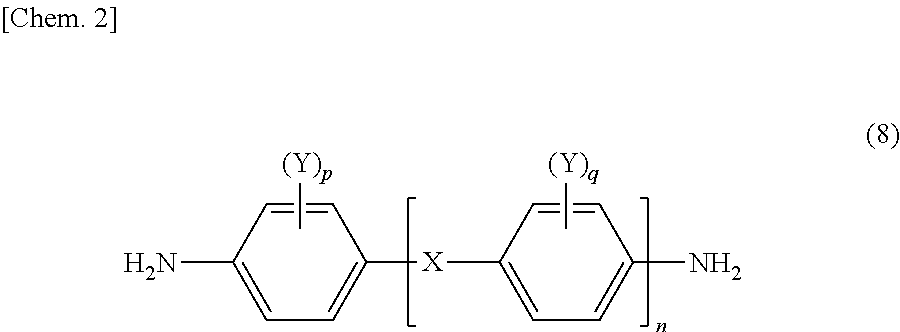Polyamide acid, thermoplastic polyimide, resin film, metal-clad laminate and circuit board
a thermoplastic polyimide and polyamide acid technology, applied in the direction of synthetic resin layered products, metal layered products, domestic applications, etc., can solve the problems of difficult adaptation to high frequency transmission, irregular light reflection at the surface, difficult fine wiring processing, etc., and achieve excellent adhesion, low roughness, and strong adhesive force
- Summary
- Abstract
- Description
- Claims
- Application Information
AI Technical Summary
Benefits of technology
Problems solved by technology
Method used
Image
Examples
example 1
[0104]Under a nitrogen stream, 0.5715 g of m-TB (0.0027 mole), 14.958 g of TPE-R (0.0512 mole) and 170 g of DMAc were put into a 300 ml separable flask, and stirring was performed at room temperature for dissolving. Next, after 3.489 g of PMDA (0.0160 mole) and 10.982 g of BPDA (0.0373 mole) were added thereto, stirring was continued at room temperature for 3 hours, a polymerization reaction was caused, and a polyamide acid solution a was obtained. The solution viscosity of the polyamide acid solution a was 6,700 cps, and the weight average molecular weight was 163,400.
examples 2 to 12
[0105]Polyamide acid solutions b to k and m were prepared in the same manner as in Example 1 except that raw material compositions shown in Table 1 and Table 2 were used and the viscosity was measured.
[0106]
TABLE 1SolventWeightDiamine componentAcid anhydrideDMAcPolyamideaverageFlexibleRigidcomponent[g] (solidacidViscositymoleculardiaminediamineTetracarboxyliccontent;Examplessolution[cps]weight(mole)(mole)acid (mole)mass %)1a6,700163,400TPE-Rm-TBPMDA170(0.0512)(0.0027)(0.0160)(15)BPDA(0.0373)2b5,800238,200TPE-Rm-TBPMDA170(0.0465)(0.0082)(0.0162)(15)BPDA(0.0378)3c6,200155,200TPE-Rm-TBPMDA170(0.0441)(0.0110)(0.0163)(15)BPDA(0.0381)4d7,200112,000TPE-Rm-TBPMDA170(0.0234)(0.0351)(0.0174)(15)BPDA(0.0405)5e8,900146,900TPE-Rm-TBPMDA170(0.0519)(0.0027)(0.0216)(15)BPDA(0.0324)6f9,500181,700TPE-Rm-TBPMDA170(0.0495)(0.0055)(0.0218)(15)BPDA(0.0327)7g8,400182,400TPE-Rm-TBPMDA170(0.0447)(0.0112)(0.0221)(15)BPDA(0.0332)
[0107]
TABLE 2SolventWeightDiamine componentAcid anhydrideDMAcPolyamideaverageFlex...
synthesis example 1
[0108]Under a nitrogen stream, 16.064 g of TPE-R (0.0550 mole) and 170 g of DMAc were put into a 300 ml separable flask and stirring was performed at room temperature for dissolving. Next, after 5.933 g of PMDA (0.0272 mole) and 8.003 g of BPDA (0.0272 mole) were added thereto, stirring was continued at room temperature for 3 hours, a polymerization reaction was caused, and a polyamide acid solution n was obtained. The solution viscosity of the polyamide acid solution n was 7,400 cps.
PUM
| Property | Measurement | Unit |
|---|---|---|
| average roughness | aaaaa | aaaaa |
| storage elastic modulus | aaaaa | aaaaa |
| storage elastic modulus | aaaaa | aaaaa |
Abstract
Description
Claims
Application Information
 Login to View More
Login to View More - R&D
- Intellectual Property
- Life Sciences
- Materials
- Tech Scout
- Unparalleled Data Quality
- Higher Quality Content
- 60% Fewer Hallucinations
Browse by: Latest US Patents, China's latest patents, Technical Efficacy Thesaurus, Application Domain, Technology Topic, Popular Technical Reports.
© 2025 PatSnap. All rights reserved.Legal|Privacy policy|Modern Slavery Act Transparency Statement|Sitemap|About US| Contact US: help@patsnap.com



